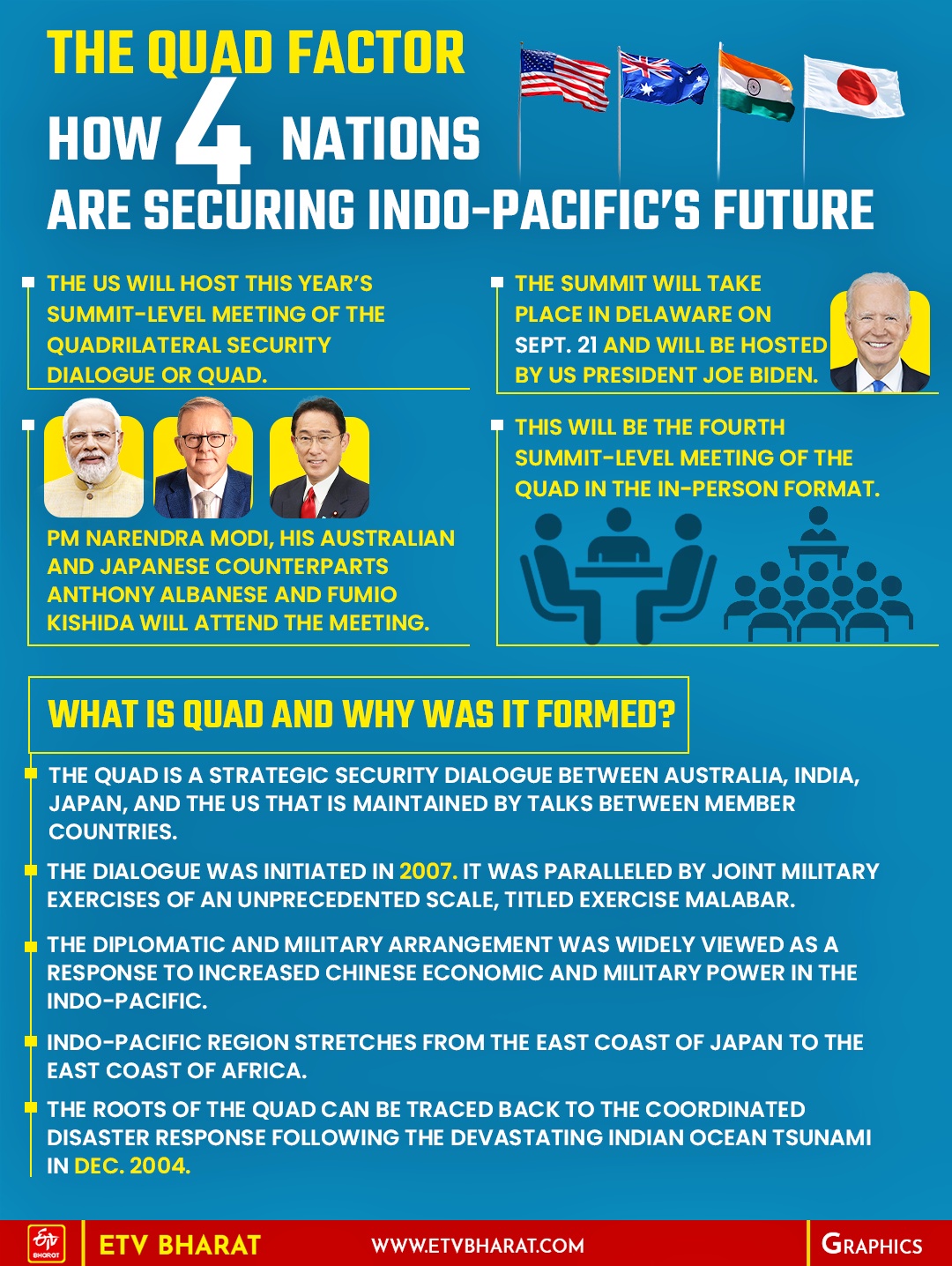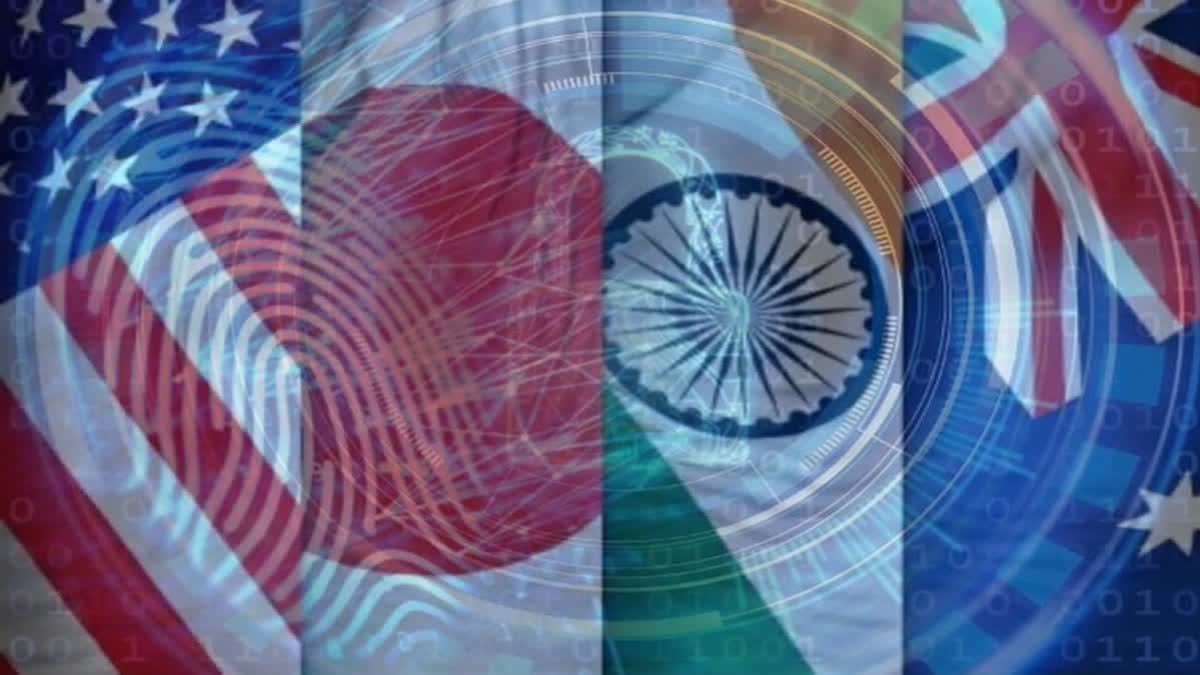New Delhi: The White House announced that US President Joe Biden will host this year’s summit-level meeting of the Quadrilateral Security Dialogue, popularly known as the Quad, at Wilmington, Delaware, on September 21, promoting a free, open and inclusive Indo-Pacific while addressing various security, economic, and regional challenges is again in focus amidst the ongoing geopolitical churn.
Prime Minister Narendra Modi and his Australian and Japanese counterparts Anthony Albanese and Fumio Kishida will attend the summit-level meeting of the four-nation grouping that outgoing President Biden will be hosting in what is his hometown.
According to a statement issued by White House Press Secretary Karine Jean-Pierre, this will be the first time that Biden will be hosting foreign leaders in Wilmington as President.
“The Biden-Harris Administration has made elevating and institutionalising the Quad a top priority, from the first-ever Quad Leaders Summit at the White House in 2021, to annual Summits since then,” Jean-Pierre said. “In recent years, Quad Foreign Ministers have met eight times, and Quad governments continue to meet and coordinate at all levels.”
This will be the fourth summit-level meeting of the Quad in the in-person format while two others were held in the virtual format.

What is the Quad and when and why was it formed?
The Quad is a strategic security dialogue between Australia, India, Japan, and the US that is maintained by talks between member countries. The dialogue was initiated in 2007 by then Japanese Prime Minister Shinzo Abe, with the support of then Indian Prime Minister Manmohan Singh, then Australian Prime Minister John Howard, and then US Vice President Dick Cheney. The dialogue was paralleled by joint military exercises of an unprecedented scale, titled Exercise Malabar. The diplomatic and military arrangement was widely viewed as a response to increased Chinese economic and military power in the Indo-Pacific, a region stretching from the east coast of Japan to the east coast of Africa.
The roots of the Quad can be traced back to the coordinated disaster response following the devastating Indian Ocean tsunami in December 2004. The four countries - India, Japan, Australia, and the US - formed the ‘Tsunami Core Group’ to coordinate relief efforts, showcasing their ability to work together effectively in a crisis.
In 2006, the idea of a formal security dialogue began gaining momentum when Japanese Prime Minister Abe proposed a strategic partnership between the four nations. Abe’s vision was to create a “democratic security diamond” to safeguard the maritime commons from the Indian Ocean to the Pacific.
The Quad was supposed to establish an “Asian Arc of Democracy”, envisioned to ultimately include countries in Central Asia, Mongolia, the Korean Peninsula, and other countries in Southeast Asia – “virtually all the countries on China’s periphery, except for China itself”. This led some critics to call the project “an anti-Chinese move”, while others have called it a “democratic challenge” to the projected Chinese century, mounted by Asian powers in coordination with the US. China sent diplomatic protests to all four members of the Quad before any formal convention of its members.
The Quad’s first official meeting took place in Manila in May 2007 on the sidelines of the Association of Southeast Asian Nations (ASEAN) Regional Forum. Australian Prime Minister Howard participated with other members in the inaugural meeting of the Quad at Cheney’s urging, one month after joint naval exercises near Tokyo by India, Japan and the US. In September 2007, further naval exercises were held in the Bay of Bengal, including Australia.
These were followed in October by a further security agreement between Japan and India, ratified during a visit by Manmohan Singh to Tokyo, to promote sea lane safety and defence collaboration; Japan had previously established such an agreement only with Australia.
Taro Aso, the then Japanese Prime Minister who had succeeded Abe, downplayed the importance of China in the Japan-India pact signed following the creation of the Quad. Then Indian Foreign Secretary Shiv Shankar Menon similarly argued that the defence agreement was long overdue because of Indian freight trade with Japan, and did not specifically target China. On the cusp of visits to China and meetings with then Prime Minister Wen Jiabao and then President Hu Jintao in January 2008, Manmohan Singh declared that “India is not part of any so-called contain China effort”, after being asked about the Quad.
However, the Quad process hit a roadblock because of Australia.
What caused the cessation of the Quad process for nearly a decade?
In 2008, Australia, under new Prime Minister Kevin Rudd, withdrew from the Quad due to concerns over China’s reaction and to prioritise its economic relationship with Beijing.
Some US strategic thinkers criticised Rudd’s decision to leave the Quad. Former Asia director of the US National Security Council, Mike Green, said that Rudd had withdrawn in an effort to please China, which had exerted substantial diplomatic effort to achieve that aim. A December 2008 leaked diplomatic cable authored by US ambassador Robert McCallum reveals that Rudd did not consult the US before leaving the Quad.
This move by Australia effectively put the Quad on hold for almost a decade.
However, Rudd’s replacement as Australian Prime Minister by Julia Gillard in June 2010 was associated with a shift in Australian foreign policy towards a closer relationship with the US and a distancing from China.
When was the Quad revived?
By 2017, the strategic environment in the Indo-Pacific had evolved significantly with growing concerns about China’s assertiveness in the South China Sea, increasing militarisation, and the growing influence of Chinese President Xi Jinping’s pet Belt and Road Initiative (BRI).
In November 2016, then US President-elect Donald Trump and Abe met and agreed to pursue what Japan called a ‘Free and Open Indo-Pacific’ strategy, originally a concept developed by former US Secretary of State Hillary Clinton. The agreement was regarded as a response to China’s BRI.
This coincided with a meeting by Japanese, Indian, Australian and US officials to continue military cooperation ahead of the ASEAN and East Asia Summits in November 2017. The meeting included discussion of China’s increased prominence in the South China Sea, and signalled Trump’s interest in reviving a formal Quad.
The Quad met five times between 2017 and 2019. During the Raisina Dialogue in New Delhi in 2018, the navy chiefs of Japan, US, Australia and India came together, one of the first indications of the revival of the Quad’s security structure. In 2019, four ministers met in New York to discuss reforming the Quad and then again in Bangkok. The next summer, India, Japan and the US invited Australia to the coordinated navy exercise at Malabar.
When were the earlier Quad summit meetings held and what were the outcomes?
The first Quad summit meeting was held in the virtual mode on March 12, 2021. Modi, US President Biden, then Japanese Prime Minister Yoshihide Suga and then Australian Prime Minister Scott Morrison participated in the summit. The Quad announced a major initiative to deliver up to one billion COVID-19 vaccine doses to the Indo-Pacific region by the end of 2022. Other key outcomes included the four countries cooperating in the fight against climate change, establishing a working group to coordinate standards on critical technologies, building secure supply chains, and a commitment to maintaining a free and open Indo-Pacific, emphasising the importance of upholding international law, especially the UN Convention on the Law of the Sea (UNCLOS).
On September 24 the same year, Biden hosted the first ever in-person summit of the Quad in Washington. The other three leaders who had participated in the earlier virtual summit attended the Washington meeting. A new initiative was introduced to ensure supply chain resilience in semiconductors and critical technologies, reflecting concerns over China’s dominance in this area. The Quad countries agreed to improve their cybersecurity posture and build better protection against ransomware attacks and other digital threats.
The group established a new working group on space, focusing on sharing satellite data for disaster response and climate change monitoring. A Quad Fellowship programme was launched to bring 100 students from the four countries to pursue studies in STEM fields.
On March 3, 2022, the Quad meeting was held again in the virtual mode. Japanese Prime Fumio Kishida was the new face apart from the other three leaders who participated. Apart from reaffirming its commitment to an inclusive Indo-Pacific region and condemned any attempts to alter the status quo by force, with a thinly veiled reference to China’s actions in the region, the Quad called for a new mechanism for humanitarian assistance and disaster relief (HADR) in the Indo-Pacific.
The fourth Quad summit – and the second in the in-person summit – was hosted by Japan Prime Minister Kishida in Tokyo on May 24, 2022. The new face among the leaders was Australian Prime Minister Anthony Albanese. Apart from the leaders reiterating their shared commitment to a free, open and inclusive Indo-Pacific, a Quad Climate Change Action and Mitigation Package (Q-CHAMP) was announced to strengthen efforts towards green shipping, clean energy including green hydrogen and climate and disaster resilient infrastructure.
The fifth Quad summit – and the third in the in-person format – was hosted by Biden in Washington on May 20, 2023. Modi, Kishida and Albanese were in attendance. The Quad’s leaders committed to supporting the region’s development, stability, and prosperity to benefit the people of the Indo-Pacific. The leaders’ ambitious efforts included major initiatives on infrastructure, maritime security, public-private partnership, climate, health, critical and emerging technologies, and space.
India was supposed to host the sixth Quad summit in the in-person format this year coinciding with the Republic Day celebration in January. However, Biden opted out citing presidential election campaign commitments. Though he has now opted out of the presidential race, he is nevertheless going ahead to host this year’s summit in the US.
What can be expected from the upcoming summit?
According to Jean-Pierre, the Quad leaders’ summit in Wilmington will focus on bolstering the strategic convergence among the four countries, advancing the shared vision of a free and open Indo-Pacific region, and delivering concrete benefits for partners in the Indo-Pacific in key areas.
“These include health security, natural disaster response, maritime security, high-quality infrastructure, critical and emerging technology, climate and clean energy, and cybersecurity,” she said.
Jean-Pierre also said that the next Quad Summit will be hosted by India.
Read More
Explained | What Drives India's Defence And Security Cooperation With Philippines



